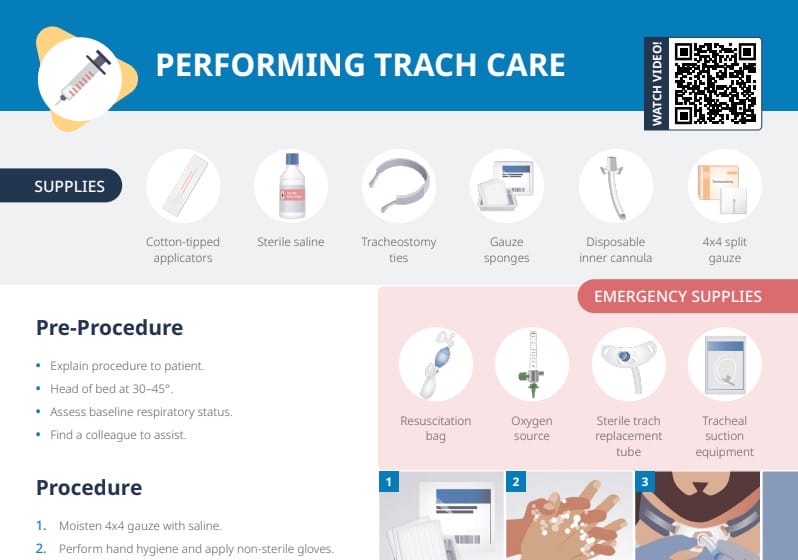What is a tracheostomy?
A tracheostomy is a hole (stoma) through the neck into the trachea (windpipe). A tube is inserted into this hole to allow air to enter the lungs bypassing the upper airways. This can be necessary when the client’s airway is blocked or if long-term ventilator support is required.
Tracheostomy vs tracheotomy
Tracheotomy is the actual surgical procedure of cutting into the trachea, typically performed under general anesthesia. Tracheostomy refers to the resulting stoma or opening that remains after a tracheotomy.
Tracheostomy vs cricothyrotomy
While a tracheostomy is the result of a planned surgical procedure and intended for long-term airway management, a cricothyrotomy is an emergency procedure performed when there’s an acute obstruction of the upper airway. An incision is made in the cricothyroid membrane (between the larynx and the trachea) to establish airflow.
Can you talk with a tracheostomy in place?
It’s possible to speak with a tracheostomy, but it might be challenging. Speaking requires air to flow over vocal cords, which can be interrupted by a tracheostomy. Affected persons may need speech therapy or a speaking valve, which allows air to be redirected over the vocal cords during exhalation.
Is a tracheostomy permanent?
A tracheostomy can be either temporary or permanent. For clients whose condition improves (e.g. after an injury), it can be temporary, while for others (e.g. with chronic respiratory issues), a tracheostomy can be a permanent solution.
How to reduce tracheostomy secretions
- Maintain good hydration
- Potentially humidify air
- Regular suctioning of trach tube
- Good oral hygiene
- Regular cleaning of tracheostomy site
What supplies are needed for performing trach care?
The basic supplies needed for performing trach care are:
- Sterile saline
- Cotton-tipped applicators
- Gauze sponges
- Tracheostomy ties
- Disposable inner cannula
- Split 4×4 gauze (Do not cut gauze yourself! Filaments from gauze may enter trach.)
What emergency supplies are needed for performing trach care?
To be prepared for emergency situations when performing trach care, you need the following supplies:
- Resuscitation bag
- Oxygen source
- Sterile trach replacement tube
- Tracheal suction equipment
What should you do if you notice signs of inflammation or infection around the stoma site?
If you notice signs of inflammation or infection around the stoma site, you should clean around the stoma site with moistened saline gauze or sterile tipped cotton applicators. Discard after each wipe. Do not get any gauze fibers in the stoma site! Dry skin around the trach site thoroughly with dry sterile 4×4 gauze.
How to prepare for trach care: what to do pre-procedure
- Explain procedure to client
- Position head of bed at 30–45°
- Assess baseline respiratory status
- Find a colleague to assist
How to perform trach care: step-by-step
- Moisten 4×4 gauze with saline.
- Perform hand hygiene & apply non-sterile gloves.
- Stabilize trach faceplate and carefully unlock inner cannula and remove. Cleanse with saline and soft brush and dry thoroughly or replace with new disposable cannula per policy.
- Insert clean or new inner cannula and lock into place.
- Remove old split gauze from around trach. Be careful not to dislodge trach!
- Hand hygiene/change non-sterile gloves.
- Assess stoma site for signs of inflammation/infection.
- Clean around stoma site with moistened saline gauze or sterile tipped cotton applicators. Discard after each wipe. Do not get any gauze fibers in the stoma site!
- Dry skin around trach site thoroughly with dry sterile 4×4 gauze.
- Place new split 4×4 gauze under trach.
- Have a colleague hold trach in place while removing trach ties.
- Put new ties on, tightening so a maximum of 1–2 fingers can fit under ties.
Related videos
How do you properly clean the inner cannula of a tracheostomy tube?
To properly clean the inner cannula of a tracheostomy tube, first stabilize the trach faceplate and carefully unlock the inner cannula and remove it. Cleanse it with saline and a soft brush and dry thoroughly or replace it with a new disposable cannula per policy. Then, insert a clean or new inner cannula and lock it into place.

